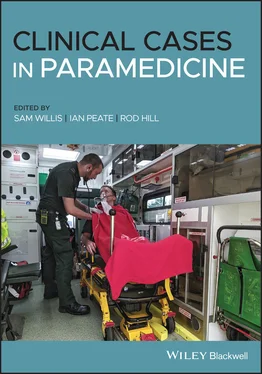1 What are your treatment priorities now and what interventions may be required to prevent further deterioration and cardiovascular collapse?In‐hospital treatments may include antiarrhythmic drugs such as betablockers or adenosine, which are often used to try to slow AVN conduction and induction of an intermittent AV block. Adenosine also has a short half‐life and works within 6–10 seconds, so its effects are short term. However, in this case the patient has no other treatments available pre‐hospital, so DC cardioversion should be initiated.
LEVEL 3 CASE STUDY
S‐T segment elevation myocardial infarction (STEMI)
| Information type |
Data |
| Time of origin |
12:30 |
| Time of dispatch |
12:32 |
| On‐scene time |
12:40 |
| Weather |
24 °C, blue skies |
| Nearest hospital |
15 minutes (no cath lab) |
| Nearest backup |
CCP, 10 minutes |
| Patient details |
Name: Robert Henson DOB: 12/02/1950 |
You have been dispatched code 1 to a GP clinic to attend a 70‐year‐old male who has presented with chest pain.
The male is not a patient of the GP clinic, he is travelling through town and developed chest pain this morning and presented to the clinic. The clinic called 000 straight away as the patient does not look well.
You know the GP clinic, it is well respected in your area.
You are greeted by the practice nurse, who states the male is not a patient of the practice, they do not have any records as he is from interstate. He walked into the practice holding his chest and looked very pale, so they called immediately. She has put him on their bed, she attempted to gain a history but he is in a lot of pain. The doctor has come in but is in the middle of an important patient procedure so has been unable to assess the patient. They attempted a 12 lead ECG but he won’t sit still.
On arrival with the patient
The patient is lying on a bed in some distress, his friend is next to him looking concerned.
Patient assessment triangle
General appearance
The patient is very pale in colour, diaphoretic, alert to you walking in the room, able to speak in sentences, holding his chest, unable to sit still.
Very pale, almost ashen in colour.
Slightly increased with the patient ‘puffing’ in pain every third breath.
SYSTEMATIC APPROACH
Danger
Nil.
Alert and orientated.
Clear.
Increased rate and effort, no accessory muscle use.
Slow strong radial pulse palpable, regular, capillary refill time <2 seconds.
RR: 24 bpm
BP: 135/75 mmHg
SpO 2: 93%
Blood glucose: 5.1 mmol/L
GCS: 15/15
Pupils equal and reactive to light (PEARL)
Colour/appearance: Pale, diaphoretic, almost grey/ashen in colour
Respiratory effort/rhythm: Increased effort, regular
Auscultate: Clear air entry both sides
Pulses: Strong radial pulses both sides
4 lead ECG: Sinus bradycardia at a rate of 40 (undiagnostic ST changes)
Head‐to‐toe survey reveals no obvious injuries/deformities, no loss of sensation, poor skin turgor, dry mucosa, nil medical alerts.
Look through the information provided in this case study and highlight all of the information that might concern you as a paramedic.
1 Given the patient’s presentation and initial observation, what is a critical vital sign that assists in the diagnosis of the condition and needs to be acquired as soon as possible?A 12 lead ECG.
2 The patient is rolling in pain and unable to respond to the nurse’s questions. What strategies could you incorporate in your practice to ensure you gather all relevant information?Reassurance, the importance of which is often underestimated. This patient appears to be very unwell and it is vital that he is assessed thoroughly. This requires good communication and plenty of reassurance, while at the same time treating the underlying problem. Remember the patient is scared, he has never had chest pain before and is frightened of what might happen.
3 What history would you like from the patient?The patient appears to be having chest pain, so it is important to ascertain what type of chest pain this is. Cardiac chest pain can be fatal and needs to be treated and assessed appropriately. In this case we need to find out when the pain began, does anything make it better or worse, what it feels like, does it radiate anywhere, what is the quality of the pain, has he ever experienced this pain before and if so does he know what it was. Use the OPQRST mnemonic:Onset: What were you doing when the pain came on?Provocation: Does anything make the pain better or worse?Quality: How do you describe the pain?Radiation: Does the pain move anywhere?Severity: On a scale of 1–10, what number would you give the pain?Timing: How long have you had it?
4 What are some of the differential diagnoses for this patient?Trauma to the area – broken ribs, pneumothorax (tension).Pulmonary embolus.Muscle strain.Pericarditis.Myocarditis.Abdominal aortic aneurysm (AAA).Aortic dissection.
5 How would you treat this patient? (Use a bulleted list.)Pharmacology:Aspirin.GTN.Oxygen (to treat hypoxia).Antiemetic (anti‐sickness).Pain relief.Make the patient as comfortable as possible.Rapid removal to a cardiac cath lab.Lots of reassurance.Close monitoring for deterioration.Prepare for cardiac arrest.Thorough history taking.
LEVEL 3 CASE STUDY
Hyperkalemia
| Information type |
Data |
| Time of origin |
14:30 |
| Time of dispatch |
14:31 |
| On‐scene time |
14:39 |
| Weather |
34 °C, very humid |
| Nearest hospital |
15 minutes |
| Nearest backup |
CCP, 15 minutes |
| Patient details |
Name: Steve Roberto DOB: 09/09/1965 |
You have been dispatched code 1 to the residence of a 55‐year‐old male who has been unwell for several days. He has collapsed and is not breathing.
The male is unconscious and his breathing is absent. CPR instructions are currently being provided over the phone.
The house is a located in a low socioeconomic neighbourhood that is well known by your ambulance service for many different calls, including a fatal stabbing on your last run of shifts. There are several people gathering outside the house due to the commotion occurring inside. You are advised that the police have also been dispatched due to the location.
The residence appears safe, with no pets in the yard and a large driveway to the side of the house. You are met at the door by a very distressed female. She states that the patient is in the bedroom and their 18‐year‐old son is performing CPR. She is extremely anxious and yelling at you to ‘hurry up and do something’. She states that the patient has been very unwell for 5 days and has missed his appointments at the renal centre. You walk through a well‐kept house into the bedroom.
Читать дальше












